 |
 |
|||
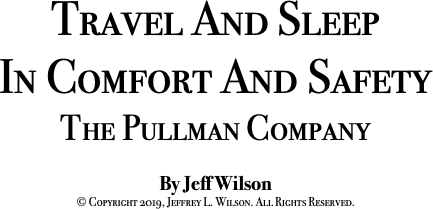
With the title Travel And Sleep In Safety And Comfort, I'm clearly not talking about today's airline experience.
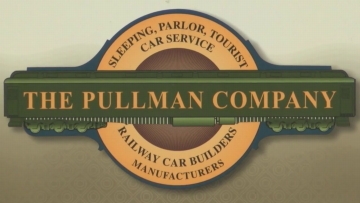 I need not describe in detail for you — the modern traveler — the inconvenient, troublesome and sometimes humiliating experience of getting from origin to destination today. We encounter security checkpoints, stressed-out and occasionally rude airline employees, cramped seats, crummy food and a boarding and deboarding process that would seem familiar to cattle at a stockyard.
I need not describe in detail for you — the modern traveler — the inconvenient, troublesome and sometimes humiliating experience of getting from origin to destination today. We encounter security checkpoints, stressed-out and occasionally rude airline employees, cramped seats, crummy food and a boarding and deboarding process that would seem familiar to cattle at a stockyard.
"Travel and Sleep In Safety And Comfort" is a motto from a different era. It was the motto of The Pullman Company, which owned and operated sleeping cars in passenger trains across America during the heyday of railroad travel.
This is about the scope and service of The Pullman Company, about its Nashville operations specifically and about several major national events that involved Pullman. Many of you have experienced Pullman travel. Those who are younger might have only heard about it or encountered today's Amtrak version.
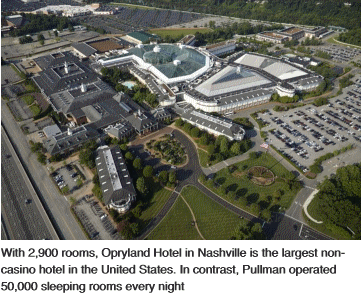 At the height of its operation, Pullman was host to 50,000 customers every night. Opryland Hotel — the largest non-casino hotel in the United States today — has fewer than 2,900 rooms. So not only was the Pullman operation more than 16 times larger than Opryland Hotel, it was spread across the country. Every guest awoke in a different city than where he went to bed.
At the height of its operation, Pullman was host to 50,000 customers every night. Opryland Hotel — the largest non-casino hotel in the United States today — has fewer than 2,900 rooms. So not only was the Pullman operation more than 16 times larger than Opryland Hotel, it was spread across the country. Every guest awoke in a different city than where he went to bed.
Set aside your memories and nightmares of your recent airline journey and recall with me a different era.
You arrive at the train station after dinner, even though the train on which you are departing doesn't pass through town until after midnight. Nonetheless, your Pullman car is waiting at the station, warm and aglow with light. The Pullman porter greets you at the door and carries your luggage to your private room. Perhaps you have reserved a roomette for one person or facilities as large as a double-bedroom for four or the peak of elegance and space, a drawing room.
A thermos of cool water is waiting in your room along with cups.
Regardless of its size, your room includes a sink, mirror, toilet, reading lights, electrical outlets and personal temperature controls. Clean towels — and they are cloth, not paper — are waiting for you along with a personal bar of soap.
When you are ready for bed, you summon the porter. With a clever twist of his special key, he pulls down a fully made bed with crisp white bed linens and a full-size pillow. Undressing, you hang your clothes on hangers so they won't be wrinkled.
And I've always thought this was one of the coolest services — if you place your shoes in the shoe locker, by morning the porter will have removed them from the other side and applied a fresh shine before replacing them, compliments of The Pullman Company.
Sliding between the crisp sheets, you extinguish the light in your room and drift off to sleep while still sitting at the station. In the middle of the night, when your train arrives, a switch engine will attach your Pullman car to the train. And you will depart with no further ado on your part. The porter will give your tickets to the train's conductor so that you aren't awakened.
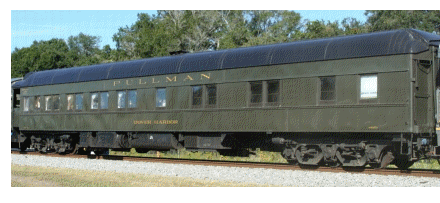 The next morning, the porter will wake you at the time you requested, delivering coffee or hot tea or even breakfast to you in bed. If you're a busy executive in the days before cell phones, you might receive a telegram that was passed aboard the train for you at a station in the middle of the night.
The next morning, the porter will wake you at the time you requested, delivering coffee or hot tea or even breakfast to you in bed. If you're a busy executive in the days before cell phones, you might receive a telegram that was passed aboard the train for you at a station in the middle of the night.
When you hear a waiter from the dining car ringing chimes in the hallway, you'll know that the nearby dining car is open for breakfast. Once you have risen, shaved and dressed, you can make your way to the dining car. Fresh aromas from the kitchen greet you along with a scene of 10 to 12 tables covered in crisp white linens, silverware and china. The table over there is set with genuine Pullman tableware.
A steward seats you, and waiters hover nearby. You select your breakfast from a menu that includes eggs, bacon, sausage, steak, pancakes or — a universal railroad specialty — French Toast. And then your breakfast is cooked to order, not reheated in a microwave.
After breakfast, you return to your room. In your absence, the porter has stored the bed and freshened your room for the day. You can sit there to work on business or enjoy the scenery while your train clips along. Or many trains had lounge cars and observation cars at the end of the train for the exclusive use of Pullman passengers.
There you might find a secretary who could take care of an outgoing telegram or other tasks. Daily newspapers would have been brought onboard. You might order a tasty beverage to ease the trip. Some of the finest trains had onboard manicurists or barbers. Imagine being shaved with a straight razor at 75 mph or faster. I shudder at the thought. The observation car offered comfortable chairs and panoramic views of the scenery from the end of the train.
When you reached your destination, the porter would carry your luggage from your room. He'd pass it to the Red Cap on the platform, who'd haul it to your taxi or other local form of conveyance.
And that is how you would travel and sleep in safety and comfort.
Lucius Beebe was a dapper and erudite New York bachelor and a writer for the New York Herald newspaper. He once said "All I want is the best of everything and there’s very little of that left."
When Mr. Beebe needed a haircut, he would board the all-Pullman 20th Century Limited at Manhattan's Grand Central Station at the end of his workday. He would spend the evening on the train, getting a shave and a haircut, having cocktails and enjoying dinner before disembarking around bedtime at Albany, New York.
Shortly thereafter, he would catch a southbound train where he had reserved a room in the Pullman car. He would spend the night onboard the train. It would arrive back at Grand Central early in the morning, but passengers weren't required to leave their Pullman rooms until 8 a.m. or so. Mr. Beebe would rise at his usual time and proceed directly back to work, fully pampered and freshly shorn.
The finest trains in the first half of the 20th Century were all-Pullman — no coach seats available. This would include New York Central's 20th Century Limited, Pennsylvania Railroad's Broadway Limited, Seaboard's Orange Blossom Special and Silver Meteor, Santa Fe's Chief and Louisville & Nashville's Pan-American.
These trains were Pullman service from front to back. Nothing but sleeping cars, lounge space, diners and observation cars. Each sleeping car had its own porter, and a Pullman Conductor was in charge. These were the limiteds, operating on tight schedules and taking priority over all other trains on the line.
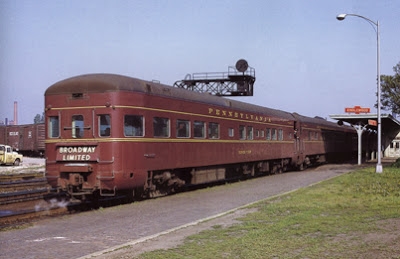 Each morning, the president of the Pennsylvania Railroad arrived at work to find a report on his desk detailing the overnight performance of the all-Pullman Broadway Limited. Woe unto the person responsible for the Broadway Limited being late.
Each morning, the president of the Pennsylvania Railroad arrived at work to find a report on his desk detailing the overnight performance of the all-Pullman Broadway Limited. Woe unto the person responsible for the Broadway Limited being late.
When do you think was the last time the president of American Airlines cared as much about your flight arriving on time?
In contrast to the all-Pullman trains were Pullman cars that had routes of their own — routes that might include two or more regular passenger trains. You would change trains — perhaps in the middle of the night — without leaving your Pullman car because the car itself would be changed from one train to another to maximize passenger convenience and comfort. Nashville was a hub for a lot of this kind of service, and I'll talk about that in a few minutes.
And while I've talked about sleeping cars with private rooms, it's also important to note that the workhorse of the Pullman fleet was the 12-1 sleeper, known to some as battlewagons. Instead of private rooms, these cars had sections.
During the day, a section was two bench seats facing each other in an otherwise open car. At night, the benches would slide down and together to form the lower berth. The Pullman porter would lower an upper berth, thereby creating, essentially, bunk beds. Heavy curtains would be drawn for privacy, and passengers shared restrooms and dressing rooms at the end of the car. This was the least-expensive and most-common form of Pullman service until after World War I.
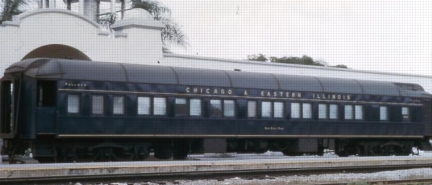 The Pullman sections were a mixed blessing. They made sleeper service affordable for more people, especially soldiers, salesmen and other low-budget business travelers. But entering the upper berth was an awkward experience. And, if you were traveling alone, you would share your section with a stranger unless you paid a premium fare for the upper berth to remain out of service.
The Pullman sections were a mixed blessing. They made sleeper service affordable for more people, especially soldiers, salesmen and other low-budget business travelers. But entering the upper berth was an awkward experience. And, if you were traveling alone, you would share your section with a stranger unless you paid a premium fare for the upper berth to remain out of service.
The details of Pullman service in Nashville varied through the years, but as a State Capital and railroad hub in the middle of the country, there was always a wide variety of service here.
We had Pullman service to Birmingham, Montgomery and New Orleans, to Chicago, to Louisville, Cincinnati and New York, to Chattanooga and Atlanta and on to Florida, to Memphis and points west, to Union City and/or Martin and on to St. Louis, to Knoxville, Bristol and Washington and to the Carolinas. There was once a Pullman car route from Nashville to Waco, Texas.
Our most interesting service was in the streamliner era and involved two trains operated by the Louisville & Nashville Railroad, which controlled the railroad business in Nashville.
Think of a large X with one bar of the X extending from Chicago to Atlanta. The other bar of the X would run from Cincinnati through Alabama to New Orleans. The two bars of the X crossed in Nashville.
The train from Chicago to Atlanta was called The Georgian. The train from Cincinnati to New Orleans was The Hummingbird.
The southbound Georgian would depart Chicago in the evening with sleeping cars bound for Atlanta and for New Orleans. The Hummingbird would depart Cincinnati, also in the evening and also with sleeping cars for Atlanta and for New Orleans. The two trains arrived in Nashville at about the same time. In Nashville, the sleeping cars would be switched so that all of the New Orleans-bound cars were in The Hummingbird, and all of the Atlanta-bound cars were in The Georgian.
The L&N effectively provided sleeping cars on four routes but required only two trains to do so. And this description is a vast oversimplification because the cars in The Hummingbird as it came south from Cincinnati had originated in places like Detroit, Toledo, Cleveland and Columbus, Ohio, and were bound beyond Atlanta for Jacksonville, Tampa and Miami.
The process was repeated in reverse every night for northbound trains.
Through similarly elaborate choreography across the country, Pullman operated 9,800 cars over a distance that would have circled the globe five times with some left over. Remember, Opryland Hotel has about 2,900 rooms. Pullman operated more than three times as many cars with each sleeping car having its own porter and carrying as many as two dozen people. It was an enormous enterprise.
So far we've talked only about Pullman's scheduled operations. Pullman also maintained a huge fleet of cars for charter assignments and extra trains. For events such as the Kentucky Derby or a convention, extra cars were added to regular passenger trains. For bigger events, an extra train was assembled.
For the Harvard-Yale football game in 1914, the New Haven Railroad ran 43 extra trains to New Haven, Conn., carrying a total of 37,500 people. This is over and above regularly scheduled trains. And the 43 trains arrived in New Haven, on average, within 3 1/2 minutes of schedule. A large portion of the cars in those trains were Pullmans.
For the Kentucky Derby in 1956, the L&N delivered about 30 extra trains to the Kentucky Derby, some from as far away as Texas. Extra trains and special cars began arriving on Thursday before the Saturday race and were parked in a yard near Louisville's Union Station. People used the Pullman cars all weekend instead of checking into hotels. The yard was equipped with showers and outdoor lights and was known as Pullman City.
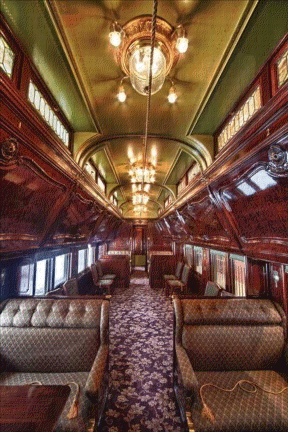 Professional baseball teams traveled in a chartered Pullman car attached to a regular train. The famous Sewanee football team of 1899, which won five games on the road in six days, traveled in a chartered Pullman car. Dozens of chartered Pullman cars carried boys and their leaders to each Boy Scout Jamboree, carried politicians to national party conventions and carried Shriners to their national confabs.
Professional baseball teams traveled in a chartered Pullman car attached to a regular train. The famous Sewanee football team of 1899, which won five games on the road in six days, traveled in a chartered Pullman car. Dozens of chartered Pullman cars carried boys and their leaders to each Boy Scout Jamboree, carried politicians to national party conventions and carried Shriners to their national confabs.
And during wartime — especially World War II — the Pullman fleet was employed to the fullest carrying soldiers and other wartime travelers across the country.
They all traveled and slept in safety and comfort on Pullman.
Not only did Pullman own and operate this huge fleet of cars. It built them, too. And that role was the source of problems that shaped The Pullman Company and the nation.
Pullman, in fact, got into this business as a sleeping car builder.
The concept of the sleeping car originated with ships at sea. If ships could have staterooms and berths, why couldn't passenger trains? The first sleeping car was operated in about 1838 between Chambersburg and Harrisburg, Pennsylvania.
Sleeping car development continued in fits and starts until after the Civil War with neither a dominant design nor a dominant company emerging.
Railroad routes began getting noticeably longer after the Civil War and after the completion of the Transcontinental Railroad in 1867. People who were going to be on a train for 40 hours straight wanted a place to lie down.
Competition with steamships on coastal routes also propelled development of sleeping car service because the steamships had staterooms.
After the Civil War, railroads realized they had their hands full trying to build new lines so they could capture the booming business of the Industrial Revolution. Designing, building and operating sleeping cars seemed like more of a distracting sideline than a lucrative enterprise.
So the railroads made deals to operate sleeping cars with third parties, the first of which was T.T. Woodruff & Company. Most of these companies were inventors and builders first and became operators only to help pay for the cars they'd already built. Sometimes they would build a car and send it out on a national tour in search of a place where it might find customers.
By end of the 19th Century, nearly 50 companies had been founded for the purpose of building or operating sleeping cars. But two companies emerged as the leaders — the Wagner Palace Car Company and the Pullman Palace Car Company. In the latter part of the 19th Century, Pullman systematically absorbed most of its competitors. In 1899, Pullman bought out Wagner and entered the 20th Century with a virtual monopoly.
In 1870, George Pullman bought an old manufacturing plant near Chicago and began to build his sleeping cars there. Around this plant, he built a company town — called Pullman, naturally enough. The Pullman Company portrayed it is a model community where workers enjoyed fair wages, generous benefits and ideal working and living conditions. In 1893 and 1894, however, some of the workers expressed a different point of view when Pullman tried to cut their wages in response to an economic recession but didn't cut the rent for living in company-owned houses in the town of Pullman.
The workers went on strike and joined the fledgling American Railroad Union. The strike spread and began to shut down rail service across America as other members of the American Railroad Union refused to operate trains that contained Pullman cars.
President Grover Cleveland called out the U.S. Army in 1894 to enforce a federal injunction and to operate the trains as a step toward breaking the strike. This resulted in riots in Chicago in which workers were killed, but it did end the strike.
The Pullman strike had two lasting effects. First, it helped to fuel the Progressive Movement. Before the strike, Pullman's model community had been seen as proof that labor could be treated well by a munificent industrialist. When this experiment failed, support for federal legislation to empower workers grew stronger, eventually resulting in the Wagner Act of 1935, which became known as labor's Magna Carta. Arguably, the strike and the resulting bad press contributed to Pullman's death in 1897 before the company reached its zenith.
The Pullman strike also launched the political career of its primary organizer, Eugene Debs. Radicalized and popularized by the Pullman experience, Debs became an outspoken national advocate for socialist solutions to America's problems. He ran for president five times over the next three decades, receiving nearly a million votes in 1912 and 1920.
After the 1894 strike was crushed, Pullman escaped serious efforts to organize its workers for a couple of decades. But after World War I, A. Phillip Randolph began to organize the Brotherhood of Sleeping Car Porters, which was the first labor union for any trade or craft that was primarily African-American workers.
 Randolph's efforts progressed slowly at first but eventually achieved success in 1937 — two years after the Wagner Act was passed — as Pullman signed a contract with the porters' union. Randolph used the national platform and prestige he gained by leading efforts to organize Pullman porters to become an advocate for ending discrimination in other aspects of American life. He used his leverage to persuade President Franklin Roosevelt to ban racial discrimination within the federal government and among companies receiving defense contracts for World War II.
Randolph's efforts progressed slowly at first but eventually achieved success in 1937 — two years after the Wagner Act was passed — as Pullman signed a contract with the porters' union. Randolph used the national platform and prestige he gained by leading efforts to organize Pullman porters to become an advocate for ending discrimination in other aspects of American life. He used his leverage to persuade President Franklin Roosevelt to ban racial discrimination within the federal government and among companies receiving defense contracts for World War II.
After the war, Randolph pressured President Truman to end racial discrimination in the armed forces. And it was Randolph who called for the March on Washington in 1963 where Dr. Martin Luther King Jr. made his famous "I Have A Dream" speech. When Randolph died in 1979, President Carter led a delegation to his funeral.
In addition to sparking labor problems, Pullman's dual role as car builder and owner-operator landed it in court on anti-trust charges in the middle of the 20th Century.
While Pullman had virtually monopolized the business of operating sleeping cars since 1899, it always had competition in the construction of passenger cars. Several large railroads built their own cars. And a company called Budd invented the process for welding stainless steel that led to the streamliner revolution beginning in the 1930s. American Car & Foundry also built passenger cars.
But Pullman blocked these companies from building sleeping cars by refusing to add to its fleet sleeping cars built by another company. This meant no Pullman conductors, no Pullman porters and no integration into the Pullman network for sleeping cars built by Budd, by ACF or by the railroads themselves.
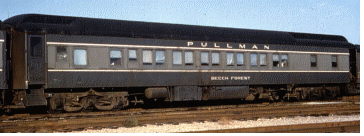 In 1940, the federal government charged Pullman with violating the Clayton Anti-Trust Act and the Sherman Anti-Trust Act. Quite frankly, the government had a pretty strong case. Lacking competition, Pullman hadn't been aggressive about modernizing its fleet. It was slow to add air conditioning and other improvements to its cars. Its fares and its return on investment were high relative to its capital investment, reflecting its monopoly position. Consumers were expressing a strong preference for private rooms instead of sections, but Pullman wasn't changing its fleet very quickly.
In 1940, the federal government charged Pullman with violating the Clayton Anti-Trust Act and the Sherman Anti-Trust Act. Quite frankly, the government had a pretty strong case. Lacking competition, Pullman hadn't been aggressive about modernizing its fleet. It was slow to add air conditioning and other improvements to its cars. Its fares and its return on investment were high relative to its capital investment, reflecting its monopoly position. Consumers were expressing a strong preference for private rooms instead of sections, but Pullman wasn't changing its fleet very quickly.
Pullman lost in court four years later and was given a choice of getting out of the the car building business or getting out of the car ownership business.
Pullman wisely chose to get quit owning the cars and sold its fleet to 59 railroads in 1947, just as passenger train patronage began to tank in the face of competition after World War II from highways and airlines. A spinoff company continued to staff and stock the cars under contract to the railroads, but extreme losses caused that company to exit the business in 1969, about two years before Amtrak.
Having initially entered the car-building business for passenger cars, Pullman had also branched into building freight cars. It merged with the Standard Car Company in 1930 and became Pullman-Standard. Many of the freight cars you see on the railroads today were built by Pullman-Standard. But even Pullman-Standard met its demise. It closed a plant in Hammond, Indiana, in 1981, and one in Butler County, Pennsylvania, in 1982. Its identity was eventually lost in a series of mergers and acquisitions into what is now known as Signal Companies Inc.
The premium name of Pullman in its heyday spread throughout our culture. Many bakeries called their large loaves of bread "Pullman" loaves. Various types of luggage are still sometimes called "Pullman" bags. Greyhound once fielded buses called "Highway Pullmans" that slept eight. The name Pullman became synonymous with sleeping cars and, more importantly, premium service.
Pullman was born in the Industrial Revolution and died when heavy industry in America took it on the chin in the 1980s.
But in its heyday, millions upon millions of Americans knew that with Pullman they could Travel and Sleep in Safety and Comfort.